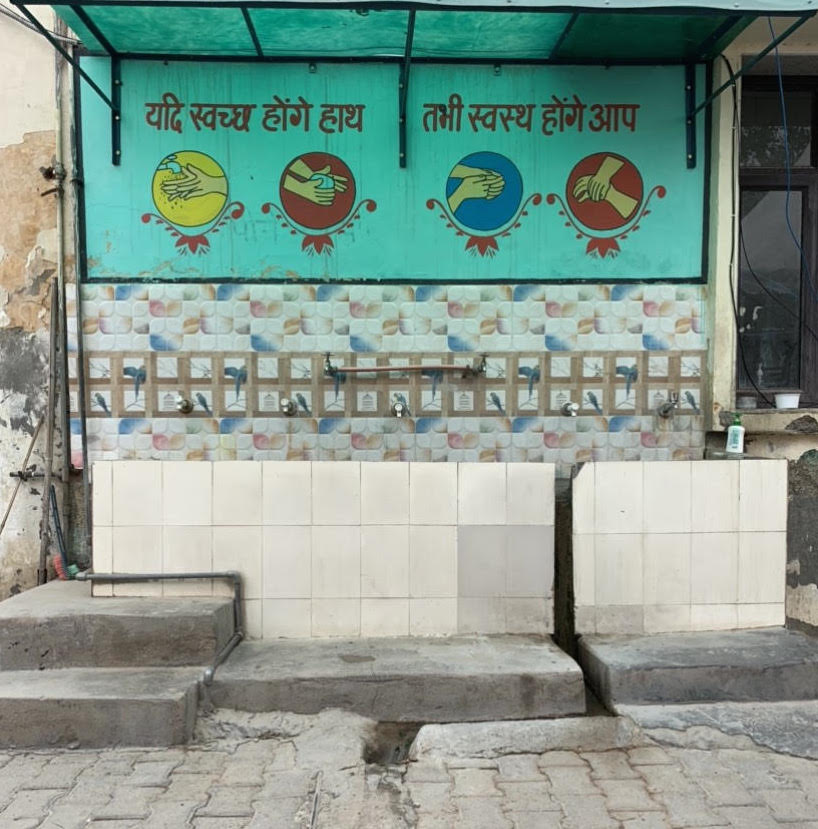Shriya Malhotra documents the experience of getting vaccinated in New Delhi India.
When slots opened up for the 18+ age group, the Indian Government vaccination booking COWIN website was quickly inundated by a rush of new hopefuls seeking to snag a vaccine dose and somehow outpace the pandemic. Within a day or two, an endless number of apps and other e-service providers appeared, offering superfast alerts once new vaccination slots were listed on the site, almost mirroring an endless faith in entrepreneurship. Apart from jamming up all my inboxes and sending me into an endless loop of errors, none of them worked for me. Then came the news that vaccine rollouts would be coordinated by states. It made me nervous to find that my state of residence, Haryana, had set up a crowd-founding campaign to deal with Covid-19. After a lot of trying, many phone glitches using the COWIN app, much panicking and frustration, dozens of one-time passwords cluttering my SMS inbox, and the help of my worried and supportive family, I managed to book my first vaccine dose: AstraZeneca, manufactured in India as Covishield.
8:15 AM
Starting early from home with a fully charged phone battery, my phone is navigating me and our domestic worker to the secondary school vaccine site in Delhi. We are in a car, wearing masks and visors and heading to where the vaccine appointment was allocated. After a sharp right, we seem to have entered one of the many urban villages that have been swallowed up by the national capital region. Suddenly, the road becomes half its width, with no fixed or discernable direction or signs to guide one.
The narrow street winds with us, rather than the other way around, and at every turn we barely avoid near collisions of people, animals, and vehicles. The rhythms of the city in the morning, punctuated by its cacophony of sound, remind me that the city is unlike a working symphony – more a jarring, aggressive, and often disjointed expression of mistakes, errors, and expression. Delhi: a city of modern constructions, swallowed-up urban villages, ancient civilizational remains, and fractured governance. A city which, although my home, sometimes feels so distant given its feverish pace of change over the last few years – squeezed in its hurried embrace of modernity and aspiration for rapid infrastructure and economic development.
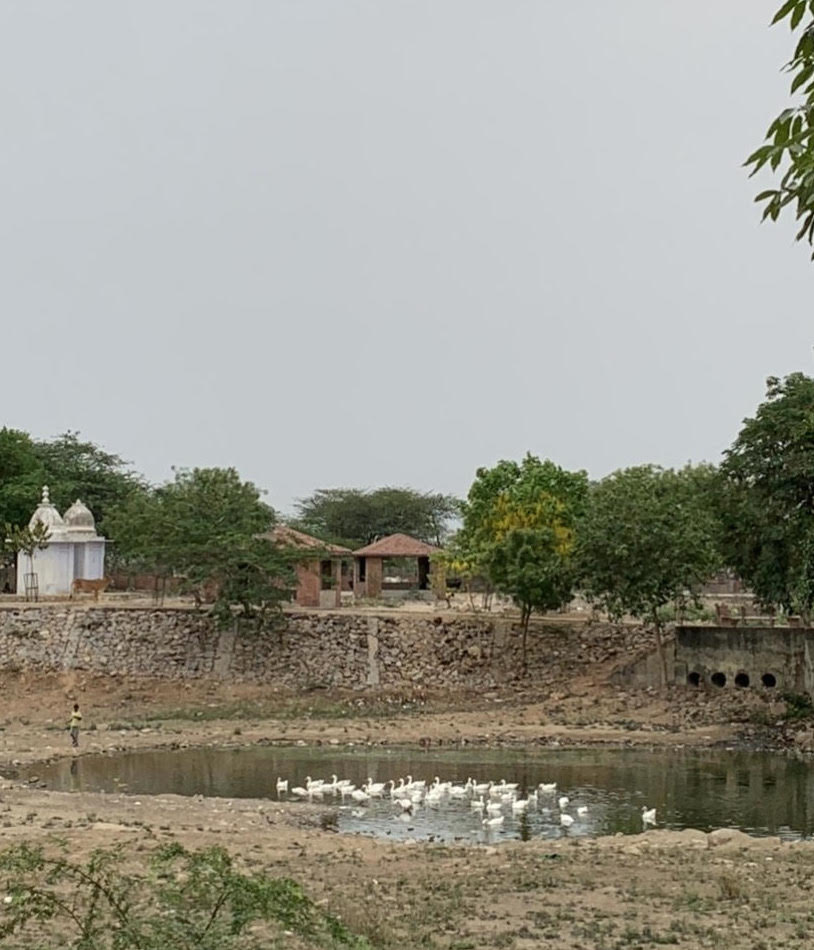
8:25 AM
We reach and stop at a good-sized lake. Unmarked and unnamed on Google maps, it reminds that Delhi is still a place that Google does not know all that well. I put on my dark glasses to help my eyes adjust to the glare of the strong summer sun. On the other side of the water, I notice in the distance a small child running with a kite. The air is absolutely still; the kite hanging onto its manja thread, limp and dragging in the still air. The child keeps running in circles, tugging at it hopefully. Everything is covered in a light film of dust that will remain till the monsoon arrives. Google Maps says this is the closest place to reach the vaccine site by car. We leave the car and start to walk.
A few feet away, a parked van is dispensing water. Youth are lined up with their masks on. It’s like being transported back in time; a short drive from our flat, to a village-like neighborhood of bare-bones infrastructure.
Navigating in India, someone once told me, is different because people use prominent local landmarks for direction, and not street names. There is definitely a development analogy there. When we were growing up, my brother used to point out to me the irony of the city’s water tankers almost always leaking in our water-starved city. Another metaphor for the geography of inequality we seem to occupy as a city of the global south, and reality of the capital of a country aspiring to find its place amongst the great powers of the world. For Dilli-wallas, we observe and experience global inequality, urban inequities, and post-colonial identity fractures daily — all rolled into one mess of thriving life.
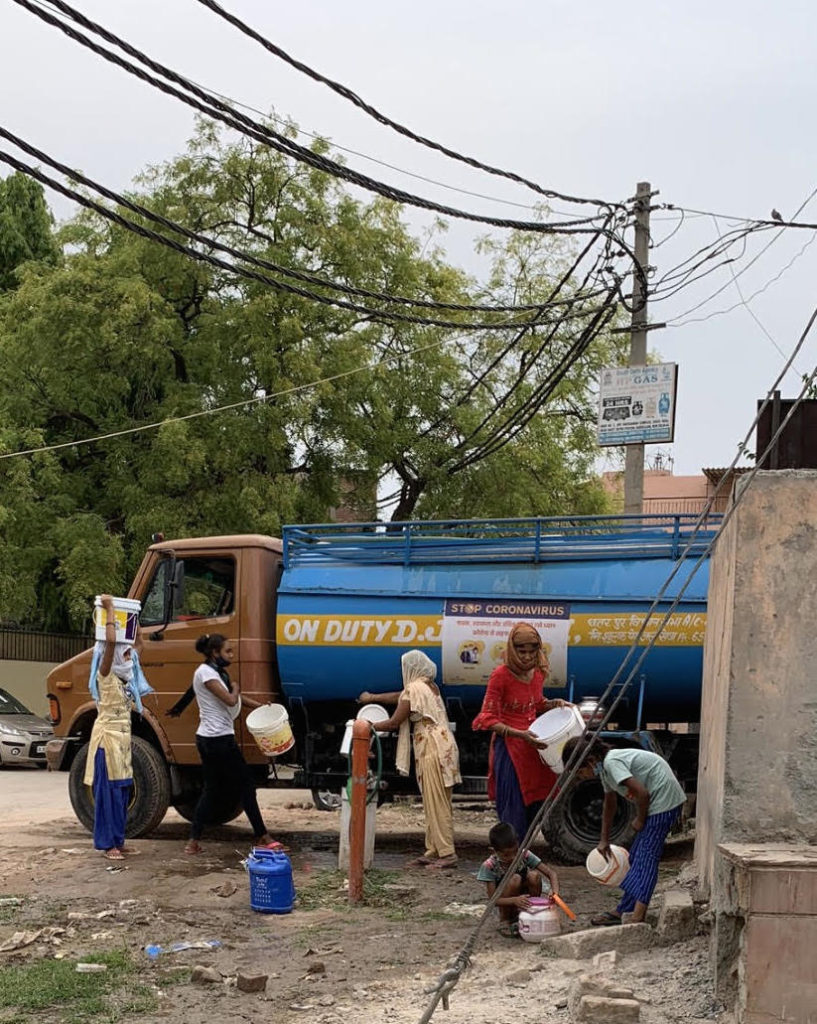
8:37 AM
We are walking alongside the lake. Its reflective blue and white shimmers — almost iridescent and cloudlike, its fauna in stark contrast to the beige and brown tones of the mud—arid, but a welcome change from concrete. Daily life unfolds around a small window-only store, and people rush by carrying their lives on the back of bicycles, scooters and motorcycles. We walk briskly past a group of old men, sitting on a charpoy (a woven bed used as a seat) and deeply inhaling hand-rolled beedis (local cigarettes). I feel they probably know where we need to go.
I ask them: “Where is the vaccine site?” and there is immediate alertness (away from their phones) and an excitement to point it out. Everyone knows where it is. There is an old man leaning against a dilapidated building, staring vacantly into urban space. His shirt’s motif almost perfectly camouflages his body against the building. Our eyes meet and he confirms the chatter, pointing me onwards to the vaccine site like a human GPS. Reconfirming the direction with a quick blink of his eyes, he resumes smoking and watching a film on his friend’s phone, peering over his shoulder.
We are finally at the inoculation site — a brightly decorated secondary school. Throngs of people are standing around in a semblance of a zigzag line. Crudely drawn circles indicate the distance we should keep from each other. No one is following rules, most people are engrossed with their phones. Time, like the summer humidity, slowly builds towards our scheduled appointment.
8:45 AM
The allocated time slot for me is 9:00 – 11:00 AM. I am curious how the 18-45 age group vaccines will be rolled out, and don’t understand why the age groups weren’t better staggered. The day temperature continues to rise. People start asking questions and, inevitably, to voice their grievances. The numbers grow, as do the murmurs of dissatisfaction. “When do we get the vaccine?”, demands one lady finally, “I’ve been standing here for half an hour.” She then turns to someone next to her and announces loudly, “I have to go somewhere at 10 AM.” He smiles at her, nods, then stares back at his phone. “I thought we got appointments”, quipped another man. The crowd has begun a steadily growing murmur.
A policeman in khaki steps out of the bright, mural-decorated school in response to the growing chatter, and starts to divide people into lines that correspond to the specific sites where they will be inoculated. A bit of confusion at first before dispersal into five different queues settles in. I nervously check for my ID card and printed registration receipt. I am worried that I may not get my shot and don’t want to miss this opportunity as it may not come again for a long time. I feel a river of sweat slowly dripping down my back as a reminder of the time. The clothes I am wearing are sticking to me the way they used to in school during the summer. A deja vu of discomfort and discipline.
8:57 AM
We are now arranged in separate lines. One group is standing near a playground. Another, alongside a wall. Three others have been moved to different sites. I am chatting with my cousin over WhatsApp. She says that, at her vaccine site, everyone is being asked to take a seat in the playground area because the vaccine vials haven’t yet arrived. “We are so tired and hot. I don’t know if the vaccines will even show up.” “Hopefully, it’s just a delay,” I tell her. I’m also reassuring myself by saying this. I type hurriedly to ask her what she’s doing to avoid the anxiety of waiting; she has downloaded films to watch on her phone. Smart. I nod to myself, listening to the same song on repeat to stay above the realities of the pandemic.
After a few minutes, we are led to a shaded area where chairs have been arranged for us to sit on. A rusted pedestal fan is pointed at us, but it is off and completely still, like a relic of a bygone era. A policeman seated at a white-clothed desk calls us up one-by-one and assigns each one a roll number. Procedures are announced; we are just expected to listen. I have to take off my headphones to do so. A nurse dressed in blue and wearing a surgical mask walks out of the school building for a break. She washes her hands and goes back in. She looks tired, but focused. I can’t imagine what it’s like to be working in essential services right now, with your life on the line and the responsibility of serving so many. Indian healthcare workers or Accredited Social Health Activist (ASHA) workers are at the lowest rung of the country’s primary health care system, receive a very modest salary, yet are the backbone of our country’s health outreach arrangement.
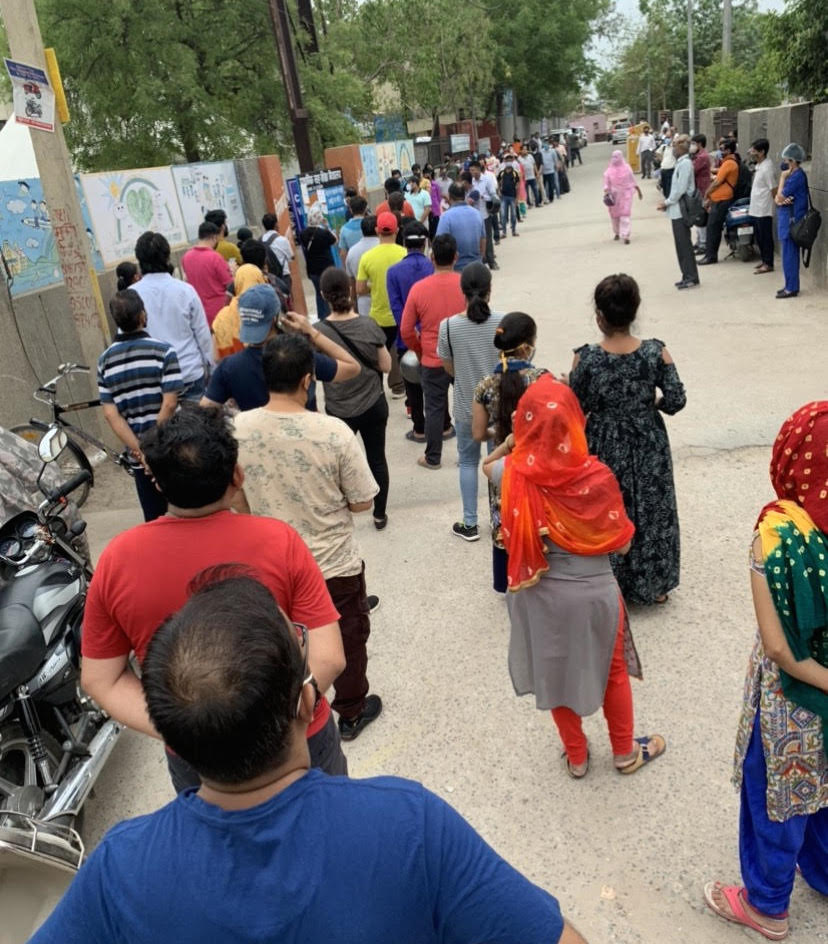
9:15 AM
We have been lined up at the adjacent school building’s entrance. A bespectacled lady is seated there with a register, filling in our names and personal details. It strikes me how Indians are so used to being shepherded around due to our huge numbers. We are informed that after the shot we will have to wait in an adjoining room for half an hour in case there are adverse reactions. “Did you eat your breakfast?” she barks at me. I am taken aback for a second and then recall a relative explaining to me that this authoritarian tone is frequently a way of showing care and familiarity. “Yes.” I feel like a reprimanded school child. “How old are you?” I tell her. She misspells my name. I feel like even one wrong answer could send her brain into an implosion. She is like a human computer, with a pen and paper – any deviation from the standard, anticipated reply, and she won’t be able to take it. Administration is an intense and difficult job and, in India unlike many other places, people still do it like robots. Her eyes glaze over as she waves me to a curtained partition. I keep eyeing the windows and hope that the air in the room is circulating well. There is a sense of permanent panic induced by the pandemic.
10:07 AM
A nurse dressed in blue and white raises her finger and calls me over with a wave and a mispronounced announcement. I almost trip over myself and sit down nervously. The vial is broken, she cleans my skin with alcohol, and squeezes my chubby upper arm. She accompanies the prick with “avoid smoking and drinking for two weeks.” It distracts my mind from the momentary pain. “Next person,” and I am herded along. The prick in my left arm coincides with an overwhelming feeling of relief. But it’s not over yet. I am now directed to an observation center in case I start to react. The room is crowded, not that well-ventilated, and has some very badly-drawn and confusing wall paintings. It’s impossible to stay socially distant from others in the room, and I wonder if my truck art inspired mask is helping at all. It is so humid, with the sweat clinging to my skin as if hanging on for dear life.
This pandemic is the first time I am aware that people are taking their parents to be vaccinated, and I mentally note with relief that my parents have already had both their doses. I wonder if in the same way that children have no option, elderly adults should be presented with a fait accompli that this is less of a choice and more of a social obligation. I wonder if someone somewhere is taking notes of the excuses made by parents.
Cities are distracting in all of their visual and unseen complexity but fascinating for the layers of information they contain. Reading the Indian city in the midst of a pandemic is both endlessly interesting and heartbreaking. As I head back to the parked car and round a corner, I almost walk into a group of children playing excitedly while weaving in and out of traffic. Dogs, goats, and cows intermingle, chewing on trash. Life seems to be going on in a way that’s very different from the world as communicated through my smartphone.
The relief I feel now needs to be viewed in the context of the then fast spreading virus and math of a possible vaccine shortage when sorely needed — it offered me the hope of immediate protection even though the timing and availability of the second dose remains unclear. The central government has since created a free vaccine program, but real-time disinformation and a lack of effective outreach has meant that many remain skeptical and hesitant. The ubiquitous presence of the phone, however, also means that this seems to be the best-documented, and perhaps first global health crisis of our digital information age. In another month, I will try to schedule my second shot. My privileges will not save me from this virus. In fact it’s people like me that travel internationally that have exposed people in my country to the virus—the global flows. Thankfully, my brother had the patience to sit through the technical errors and register me. Privilege in this case might offer me the time to consider how we have gotten to this point and what can be done to better prepare ourselves. I really hope that we somehow get more vaccines in time for everyone to quickly get both their doses. Apart from my general annoyance with the unreliable but glorified uses of digital technology, I worry about informal economies and migrants who come to the city; so many people are trapped without support networks that give them information or awareness. The unethical-ness of social exclusions while compromising personal security for surveillance.
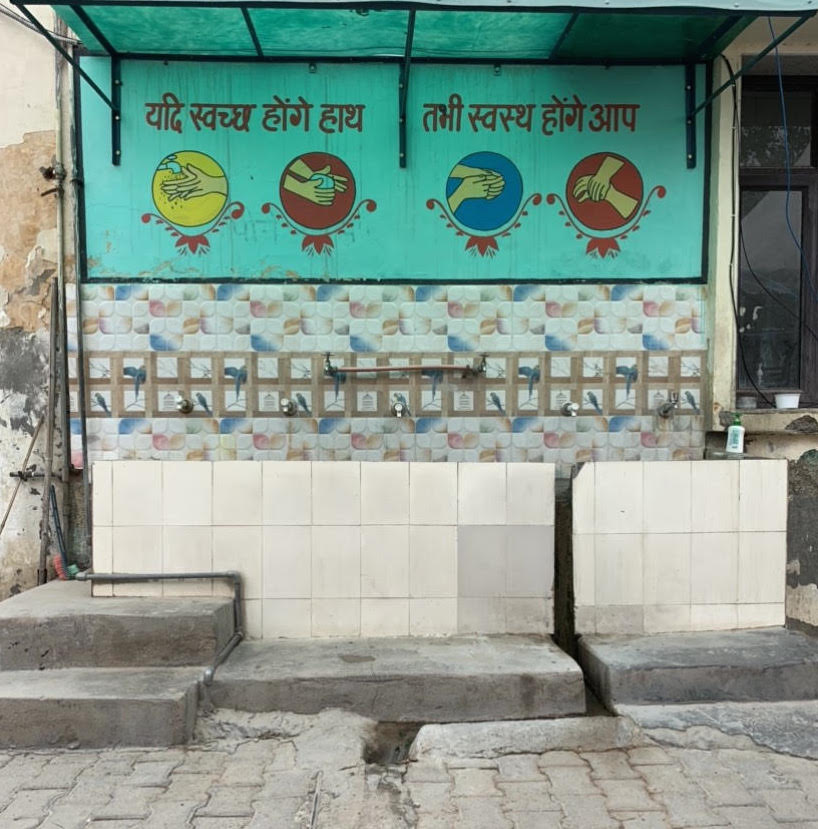
Shriya Malhotra graduated from the GPIA in 2009 with a focus on Cities and Urbanization. She consults on projects that leverage art, media and technology for social change.

